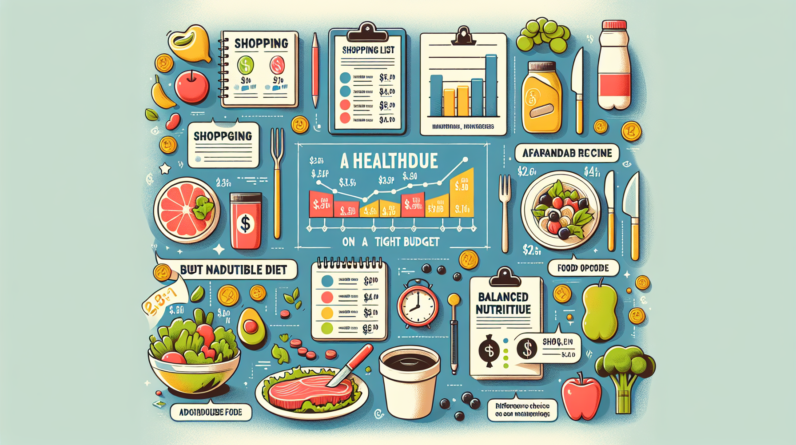
In today’s fast-paced and budget-conscious world, maintaining a healthy diet can often become a daunting task. We all want to make nutritious choices for our well-being, but sometimes our wallets just don’t seem to align with our health aspirations. However, fret not! In this article, we will explore practical strategies and tips for individuals looking to maintain a healthy diet while on a budget. With a little planning, mindfulness, and creativity, you can strike a balance between your health goals and your financial reality.

Meal Planning
Meal planning is a crucial step in maintaining a healthy diet on a budget. By planning your meals in advance, you can ensure that you have a balanced and nutritious menu throughout the week. This allows you to make a shopping list of the necessary ingredients and avoid impulse purchases.
Plan your meals in advance
Take some time at the beginning of each week to plan out your meals. Consider your dietary needs and preferences, as well as any special occasions or events that may require adjustments to your usual menu. By planning ahead, you can make sure you have all the necessary ingredients on hand and avoid last-minute takeout or unhealthy choices.
Consider batch cooking
Batch cooking is a time-saving technique that involves preparing larger quantities of food and portioning them out for future meals. This not only saves you time during the week but also allows you to take advantage of bulk buying discounts. Simply cook larger batches of dishes such as soups, stews, or casseroles, and freeze portions for later use.
Utilize leftovers
Don’t let leftovers go to waste! Instead, get creative with using them in new dishes. For example, leftover roasted chicken can be shredded and used in sandwiches or salads, while cooked grains and veggies can be turned into a delicious stir-fry. Leftovers can also be frozen and eaten at a later time when you’re in need of a quick and convenient meal.
Smart Shopping
Smart shopping involves making informed choices while grocery shopping to maximize your budget and ensure that you’re getting the most value for your money.
Make a grocery list
Before heading to the store, make a detailed grocery list of the items you need. Stick to the list while shopping to avoid impulse purchases and unnecessary expenses. Focus on buying the ingredients you need for your planned meals and try to avoid buying items that may go to waste if not used promptly.
Stick to a budget
Set a budget for your grocery shopping and stick to it. This will help you prioritize your purchases and avoid overspending. Look for discounts and sales, and compare prices between different stores to find the best deals. It can also be helpful to shop with cash rather than relying on a credit or debit card, as this can help you stay within your budget.
Shop seasonal and local produce
Seasonal produce is not only fresher and tastier, but it’s often more affordable too. By buying fruits and vegetables that are in season, you can take advantage of lower prices and support local farmers. Local produce may also be less expensive since it doesn’t have to travel long distances to reach the store, reducing transportation costs.
Buy in bulk
Buying in bulk can be a cost-effective way to stock up on essentials and pantry staples. Look for bulk bins or larger packages of items such as grains, legumes, and spices. Buying in bulk not only saves you money but also reduces packaging waste. Just make sure to store bulk items properly to maintain their freshness and quality.
Getting Creative with Ingredients
Getting creative with ingredients is an excellent way to save money while still enjoying flavorful and nutritious meals. By thinking outside the box and trying new things, you can make the most of your grocery budget.
Opt for plant-based proteins
Plant-based proteins such as beans, lentils, tofu, and tempeh are often more affordable than meat and poultry. They are also high in fiber and essential nutrients, making them a healthy choice for your budget-friendly meals. Experiment with different vegetarian and vegan recipes or try replacing a portion of the meat in your dishes with plant-based proteins.
Use cheaper cuts of meat
Cheaper cuts of meat, such as chicken thighs or pork shoulder, can be just as delicious and nutritious as more expensive cuts. These cuts often have more flavor and become tender when cooked slowly or with moist heat methods. Incorporate them into stews, soups, or slow-cooker recipes to make the most of their qualities without breaking the bank.
Incorporate whole grains and legumes
Whole grains and legumes are not only affordable but also packed with essential nutrients. They can be used as a base for many dishes, providing a good source of carbohydrates, protein, and fiber. Experiment with different grains like brown rice, quinoa, or barley, and combine them with legumes to create hearty and filling meals.
Experiment with frozen fruits and vegetables
Frozen fruits and vegetables are a budget-friendly alternative to fresh produce, especially when certain items are out of season. They are often flash-frozen at their peak ripeness, preserving their nutritional value. Use them in smoothies, stir-fries, or soups for a convenient and affordable way to include more fruits and vegetables in your diet.
Meal Prepping
Meal prepping is a time-saving and money-saving strategy that involves preparing meals in advance to have them ready for busy days or when time is limited.
Prepare meals in advance
Dedicate a specific day or time during the week to prepare your meals in advance. This can include cooking proteins, chopping vegetables, or assembling casseroles or salads. By having meals partially or fully prepared, you can save time during the week and avoid the temptation of ordering takeout or reaching for unhealthy convenience foods.
Utilize freezer-friendly containers
Invest in freezer-friendly containers that can hold individual portions or larger batches of meals. This allows you to portion out meals and store them in the freezer for future consumption. Freezing meals not only preserves their freshness but also prevents food waste by extending their shelf life.
Portion control
When meal prepping, consider portion sizes to avoid overeating or wasting food. Use measuring cups or a food scale to portion out ingredients and ensure that each meal is appropriately balanced. This can help you control both your portion sizes and your budget, as you’ll have a better understanding of how much food you actually need.

Cooking at Home
Cooking at home is a key component of maintaining a healthy diet on a budget. By preparing meals from scratch, you have control over the ingredients used and can save money compared to eating out or relying on convenience foods.
Limit eating out
Eating out can quickly become expensive, especially if done regularly. Limiting the frequency of dining out, whether at restaurants or ordering takeout, can significantly impact your food budget. Instead, embrace cooking at home and view it as an opportunity to try new recipes and experiment with different flavors.
Avoid processed and convenience foods
Processed and convenience foods are often more expensive and less nutritious than homemade meals. They may also contain added sugars, unhealthy fats, or excessive sodium. By cooking at home, you can use fresh, whole ingredients and have complete control over the nutritional content of your meals, ensuring that they are balanced and wholesome.
Explore different cooking methods and recipes
Don’t be afraid to step out of your comfort zone and explore different cooking methods and recipes. Try baking, grilling, steaming, or stir-frying your ingredients to vary the flavors and textures. Experiment with new spices, herbs, or marinades to add excitement to your meals. The internet and cookbooks are great resources for finding inspiration and expanding your cooking repertoire.
Avoiding Food Waste
Avoiding food waste is not only environmentally responsible but also beneficial for your budget. By making the most of the food you purchase, you can reduce waste and save money.
Properly store and preserve perishable items
To prolong the shelf life of perishable items, it’s important to store them properly. Keep fruits and vegetables in the refrigerator or a cool, dark place, and ensure they are dry to prevent spoilage. Use airtight containers or freezer bags to store leftovers or prepped meals, and label them with dates to keep track of their freshness.
Use leftovers creatively
Leftovers can be transformed into entirely new dishes with a bit of creativity. For example, leftover roasted vegetables can be blended into soups or turned into tasty frittatas. Get creative with combining different ingredients and flavors to make the most of your leftovers and create exciting meals.
Repurpose food scraps
Instead of throwing away food scraps, find ways to repurpose them. Vegetable peels, for example, can be used to make flavorful vegetable stock, while fruit scraps can be transformed into delicious homemade jams or sauces. Get into the habit of saving scraps and experimenting with different recipes to reduce waste and maximize your ingredients.
Utilizing Coupons and Discounts
Coupons and discounts can be valuable tools in maximizing your grocery budget. By being mindful of sales and deals, you can save money on your regular purchases.
Look for sales and discounts
Keep an eye out for sales and discounts at your local grocery store. Many stores offer weekly or monthly specials on different items. Check the store’s website or promotional flyers to find out what items are on sale and plan your meals accordingly.
Clip coupons
Coupons can be a great way to save money on specific items. Look for coupons in newspapers, magazines, or even online coupon websites. Clip and organize your coupons by expiration date or category to make them easily accessible when you go shopping.
Shop during off-peak hours
Shopping during off-peak hours can sometimes result in finding discounts or reduced prices on certain items. Many grocery stores mark down perishable items later in the day to make room for fresh stock. By shopping during these times, you may be able to find discounted produce, bakery items, or meat that is nearing its sell-by date but is still perfectly good to consume.
Grow Your Own Food
Growing your own food is not only a rewarding hobby but also a cost-effective way to enjoy fresh produce. Even if you have limited space, you can still grow herbs or vegetables in containers or small raised beds.
Start a garden
If you have access to a yard or outdoor space, consider starting a garden. Choose vegetables or herbs that are easy to grow and suited to your climate. Seeds and seedlings are often more affordable than buying produce at the grocery store, and you’ll have the satisfaction of knowing exactly where your food is coming from.
Plant herbs and vegetables
If you don’t have a yard, you can still grow herbs and vegetables in containers. Herbs like basil, mint, or rosemary can be grown on a windowsill or a balcony. Leafy greens like lettuce or spinach can also thrive in pots. Growing your own herbs and vegetables not only saves you money but also allows you to enjoy the freshness and flavor of homegrown produce.
Healthy Eating on a Small Budget
Maintaining a healthy diet on a small budget is possible with the right strategies and choices. Prioritizing whole, unprocessed foods and being mindful of your nutritional needs can help you make the most of your budget.
Focus on whole, unprocessed foods
Whole, unprocessed foods are often more affordable and more nutritious than processed counterparts. Choose whole grains like oats, brown rice, or quinoa, and incorporate fresh fruits and vegetables into your meals. Opt for lean proteins like eggs, beans, or canned tuna, and avoid highly processed snacks or desserts.
Drink water instead of sugary drinks
Sugary drinks can be expensive and contribute empty calories to your diet. Instead of purchasing soda, juice, or other sugary beverages, opt for water. Water is free, hydrating, and essential for your overall health. If you’re looking for flavor, infuse water with fresh fruits or herbs for a refreshing and cost-effective alternative.
Prioritize nutrition over quantity
When on a tight budget, it’s important to focus on the nutritional value of the foods you’re purchasing rather than the quantity. Instead of reaching for cheaper, calorie-dense foods, prioritize nutrient-dense options. These include foods that are high in vitamins, minerals, and fiber, such as fruits, vegetables, legumes, and whole grains. By prioritizing nutrition, you can make sure your body receives the essential nutrients it needs without breaking the bank.
Community Resources
Take advantage of community resources to further support your healthy eating efforts on a budget. Many programs and initiatives exist to provide access to nutritious food and foster a sense of community.
Food banks and assistance programs
Food banks and assistance programs are valuable resources for individuals and families in need of food support. These organizations provide fresh produce, pantry staples, and sometimes even meals to those who require assistance. Research the food banks and assistance programs in your area to find out what resources are available to you.
Local farmers markets
Local farmers markets offer a wide variety of fresh, locally grown produce at reasonable prices. They also provide an opportunity to connect with local farmers and learn about the quality and source of the food you’re purchasing. Visit your nearest farmers market to discover affordable, seasonal produce and support local agriculture.
Share meals with neighbors or friends
Sharing meals with neighbors or friends can be a cost-effective and enjoyable way to diversify your diet and build community. Consider organizing potluck dinners or cooking swaps where each participant contributes a dish. This allows you to sample different cuisines and share the workload and cost of preparing meals.
Swap recipes and produce with others
Exchange recipes and produce with others in your community to further diversify your meals. A surplus of homegrown tomatoes, for example, can be traded for fresh herbs from a neighbor’s garden. By swapping ingredients and sharing ideas, you can make the most of your resources and expand your culinary repertoire.
In conclusion, maintaining a healthy diet on a budget requires strategic planning, creative thinking, and making informed choices. By implementing meal planning, smart shopping, getting creative with ingredients, meal prepping, cooking at home, avoiding food waste, utilizing coupons and discounts, growing your own food, prioritizing healthy eating, and tapping into community resources, you can enjoy nutritious and delicious meals without breaking the bank. With a little effort and mindfulness, eating well can become an affordable part of your lifestyle.






